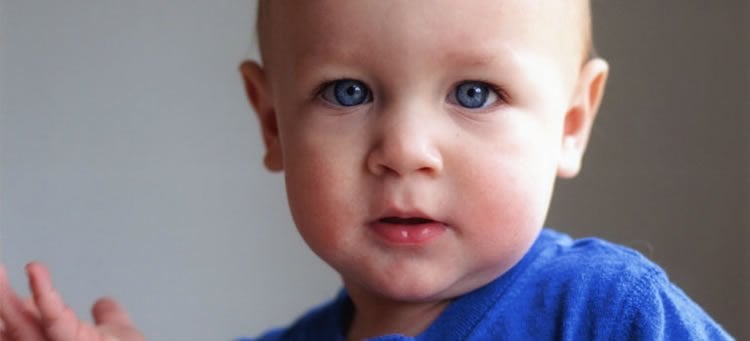Summary: According to a new study in Developmental Science, infants at the age of one already tend to prefer speakers of their native language. However, they do not necessarily view those who speak different languages negatively. Findings suggest that positivity toward familiar groups may be innate, while negativity toward unfamiliar groups may be learned.
Source: University of British Columbia.
By the age of one, infants already prefer speakers of their native tongue, but do not necessarily view speakers of an unfamiliar language negatively, according to new UBC research. The findings suggest that, while positivity toward familiar groups may be innate, dislike for unfamiliar groups appears to be a learned behaviour.
“Persistent discrimination and conflict across cultures has led psychologists to question whether we are naturally inclined to like people who are similar to ourselves and to dislike those who are different, or whether we are taught to feel this way,” said Anthea Pun, the study’s lead author and a graduate student in the UBC department of psychology. “These findings suggest both are true: liking people who are similar to ourselves seems to be an innate bias, but disliking those who are different is something we likely learn later.”
Past research has found that, by the age of three, children show positive biases toward people who are similar to them and negative biases towards those who are different. In this study, the UBC researchers turned their attention to infants to determine when and how these biases first emerge.
They conducted six experiments involving 456 infants between the ages of eight months and 16 months at Science World’s Living Lab located at TELUS World of Science in Vancouver. The experiments examined how quickly infants habituated to either familiar or unfamiliar language speakers performing prosocial (giving) behaviour or antisocial (taking) behaviour.

Habituation measures infants’ rate of processing pictures and sounds presented to them. When the information is consistent with infants’ expectations, attention declines at a faster rate. By measuring infants’ rate of habituation, the researchers were able to independently measure whether infants had formed positive or negative evaluations of people speaking familiar and unfamiliar languages.
Across all experiments, the researchers found that, by one year of age, infants not only think of speakers of their native language as good, but they also expect them to be prosocial. The infants appeared to be surprised when observing speakers of their native language engaging in antisocial behaviour. Infants of this age, however, do not appear to have any positive or negative expectations of speakers of an unfamiliar language, suggesting that negativity toward groups different from their own is likely learned after the first year of life, the researchers found.
By the age of one, infants already prefer speakers of their native tongue, but do not necessarily view speakers of an unfamiliar language negatively, according to new UBC research. The findings suggest that, while positivity toward familiar groups may be innate, dislike for unfamiliar groups appears to be a learned behaviour.
“This study provides critical insight into the origins of social group bias by allowing researchers to understand how positivity and negativity toward groups develops independently,” said Andrew Baron, the study’s senior author and associate professor in the UBC department of psychology.
Source: University of British Columbia
Image Source: NeuroscienceNews.com image is adapted from the UBC news release.
Video Source: The video is credited to ubcpublicaffairs.
Original Research: Abstract for “Foundations of infants’ social group evaluations” by Anthea Pun, Matar Ferera, Gil Diesendruck, J. Kiley Hamlin, and Andrew Scott Baronin JDevelopmental Science. Published online July 13 2017 doi:10.1111/desc.12586
[cbtabs][cbtab title=”MLA”]University of British Columbia “Ga-Ga, Goo-Goo, Why a Baby May Like You.” NeuroscienceNews. NeuroscienceNews, 15 July 2017.
<https://neurosciencenews.com/native-language-babies-7087/>.[/cbtab][cbtab title=”APA”]University of British Columbia (2017, July 15). Ga-Ga, Goo-Goo, Why a Baby May Like You. NeuroscienceNew. Retrieved July 15, 2017 from https://neurosciencenews.com/native-language-babies-7087/[/cbtab][cbtab title=”Chicago”]University of British Columbia “Ga-Ga, Goo-Goo, Why a Baby May Like You.” https://neurosciencenews.com/native-language-babies-7087/ (accessed July 15, 2017).[/cbtab][/cbtabs]
Abstract
Foundations of infants’ social group evaluations
Previous research has suggested that infants exhibit a preference for familiar over unfamiliar social groups (e.g., preferring individuals from their own language group over individuals from a foreign language group). However, because past studies often employ forced-choice procedures, it is not clear whether infants’ intergroup preferences are driven by positivity toward members of familiar groups, negativity toward members of unfamiliar groups, or both. Across six experiments, we implemented a habituation procedure to independently measure infants’ positive and negative evaluations of speakers of familiar and unfamiliar languages. We report that by 1 year of age, infants positively evaluate individuals who speak a familiar language, but do not negatively evaluate individuals who speak an unfamiliar language (Experiments 1 and 2). Several experiments rule out lower-level explanations (Experiments 3–6). Together these data suggest that children’s early social group preferences may be shaped by positive evaluations of familiar group(s), rather than negative evaluations of unfamiliar groups.
“Foundations of infants’ social group evaluations” by Anthea Pun, Matar Ferera, Gil Diesendruck, J. Kiley Hamlin, and Andrew Scott Baronin Developmental Science. Published online July 13 2017 doi:10.1111/desc.12586






